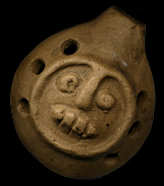
Almost all these ways of Aymara music and dance no longer exist today.
According to different archaeological findings, one of the ancient musical instruments has been the phunkhullu. It had an evolution in their making materials from the clay, bony materials, until at the present vegetable canes, specially the Andean bamboo ones(suqusa, siqusa) of the zone of the Yungas and low valleys.
The bamboo cane, allows the invention of siku (siqus) and the sikuri (siqus phusiri).
Between the descendants of phunkhullu are the pinkillos, chacallos, quena-quenas, moseños, lawa k'umus and tarqas.
After the Spanish guitar influence was invented the charango (khirkhinchu), in some place of the north of the Potosí.
Musical Instruments

Pincullo o Pinquillo (Aerophone)
Vertical cane flute that measures 50 cetimeters, with an extreme superior mouthpiece. It gives a sharoer sound than the Quena.
Pusa o Sicura (Aerophone)
It is known by its european name Zampoña. It is formed by 12 hollow canes placed in two rows from minor to mayor, tied up in scale, when blowed give of certain musical notes. The opposite end of the canes is closed. A Zampoña cannot give a complete melody given the small number of notes it has. To accomplish it various musicians get together, were each one carries out a different Zampoña, building like that complete melodys, of beautifull sounds. It is a custom that the players get together with percussion accompaniment. It is common in Bolivia, Peru and the north of Chile. It is also called Laca, in Aymara it is Siku o Sikuri.
Charango (cordófono):

Charango (Cordophone)
A Guitar, indigenous replica of the spanish guitar, that its approximate total length is about seventy centimeters. It has a wooden neck, similar to the european instruments, the front part or the top has and 8 shape, like the guitar. The resonance box is of the shell of a quirquincho. It´s formed by ten strings, tuned in five double orders, mainly metallic.
Ocarina (Aerophone)
The use of the Ocarina has been lost in the Chilean North; but is kept in Putre, on the zone of Belen in Aiquina and in the Bolivian highlands.
Its length variates from 15 to 28 centimeters and its diameter goes from 5 to 10 cms. It is hard to make and to play, that´s why it´s been lost.